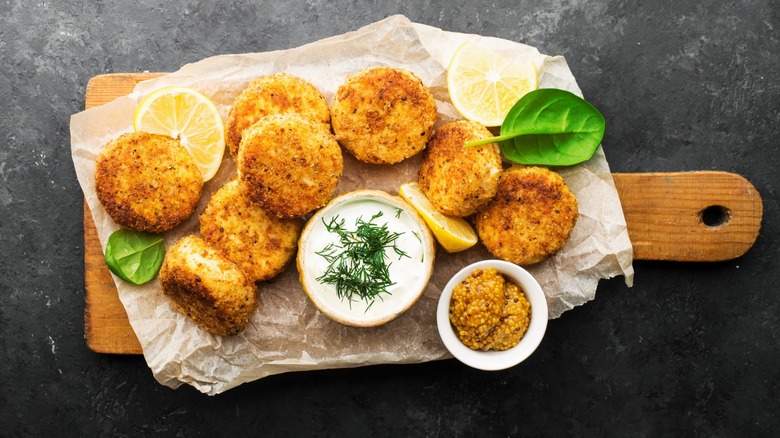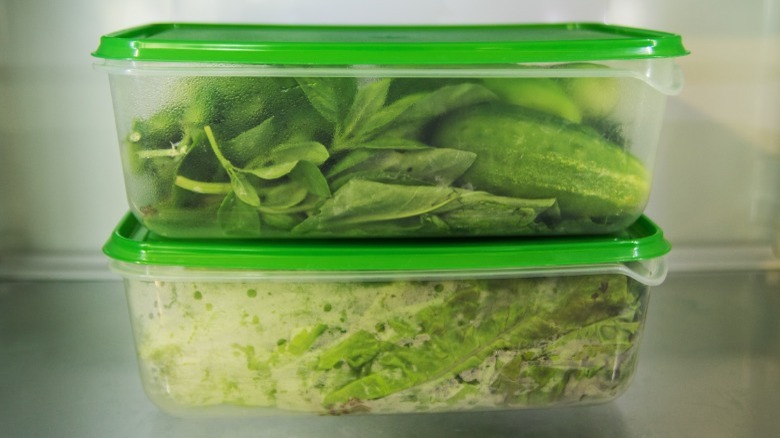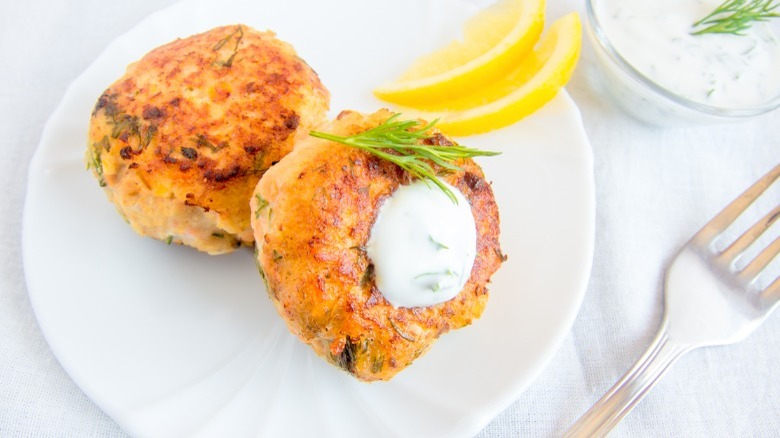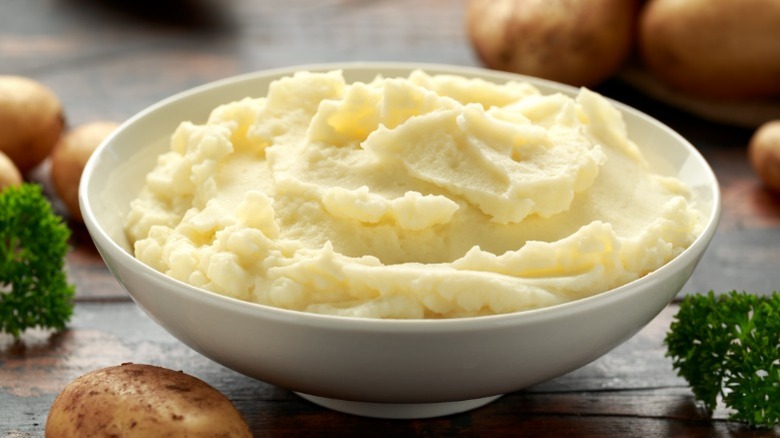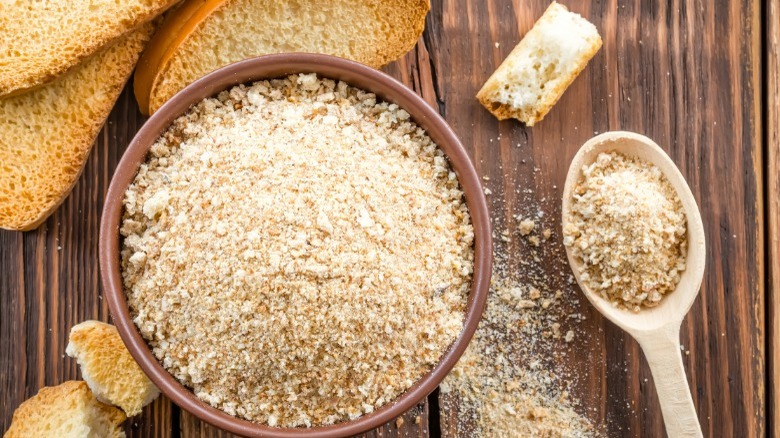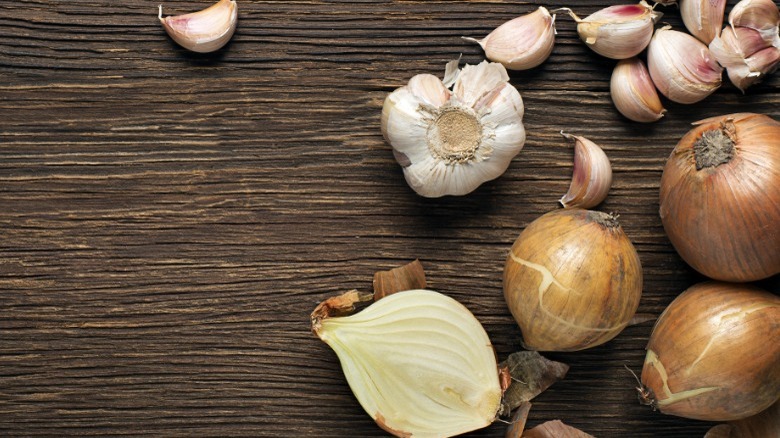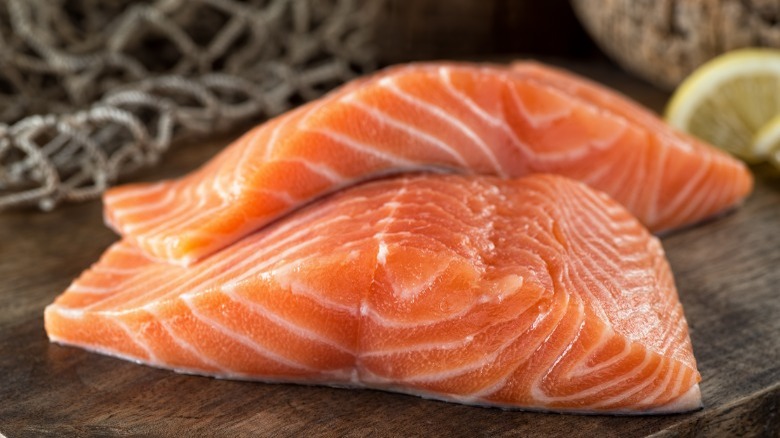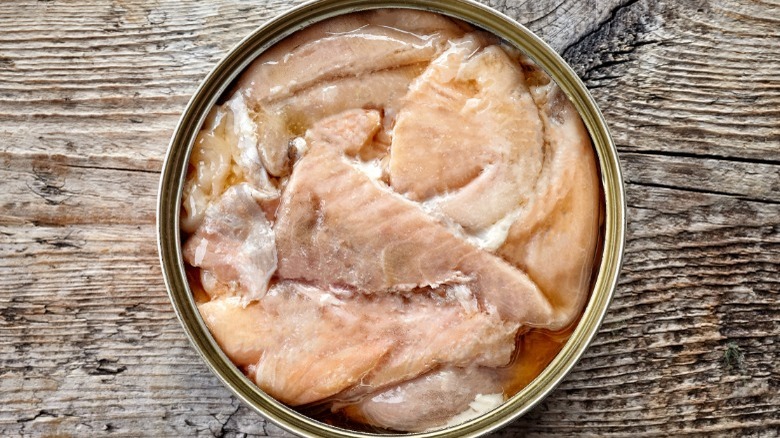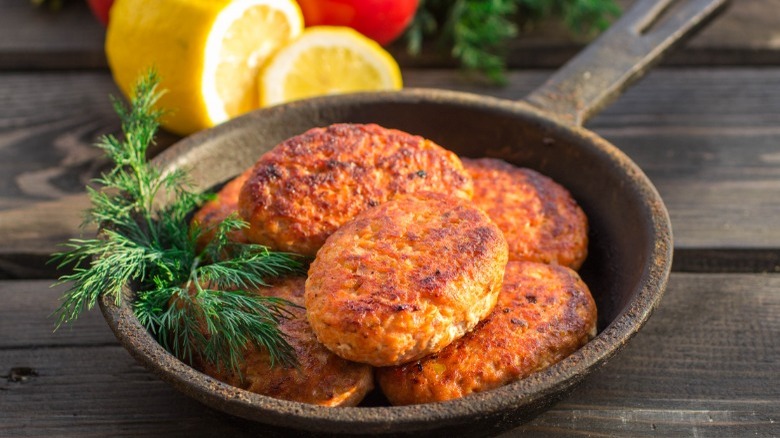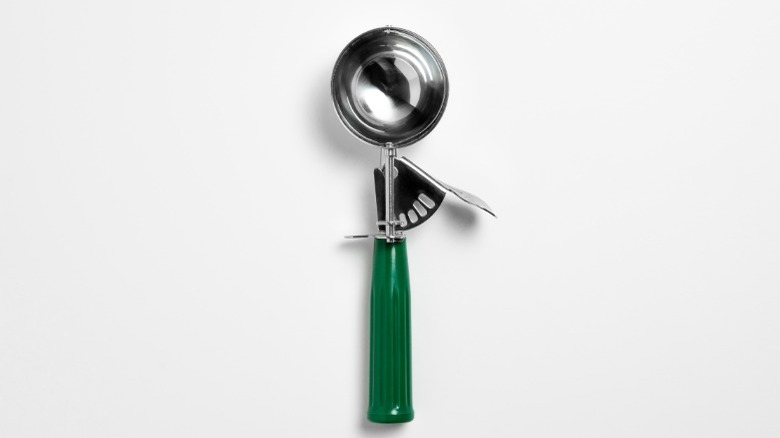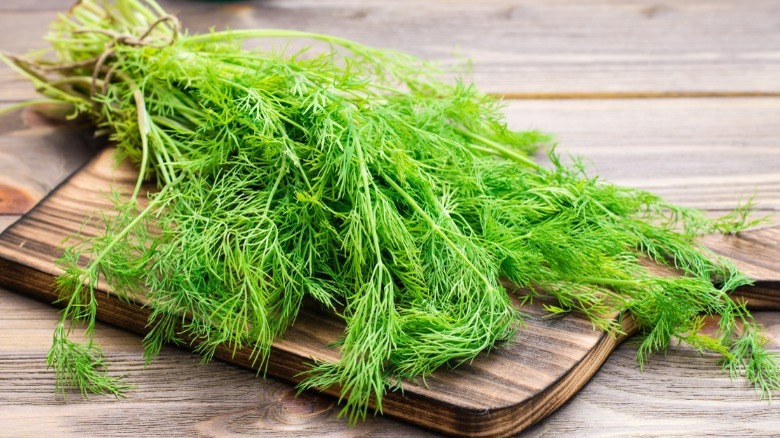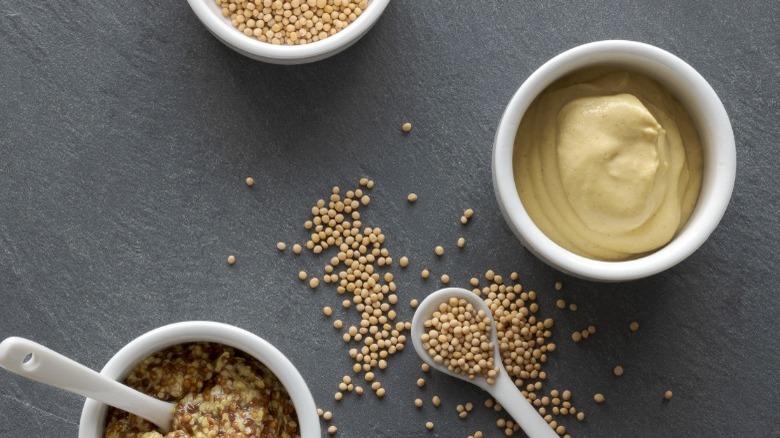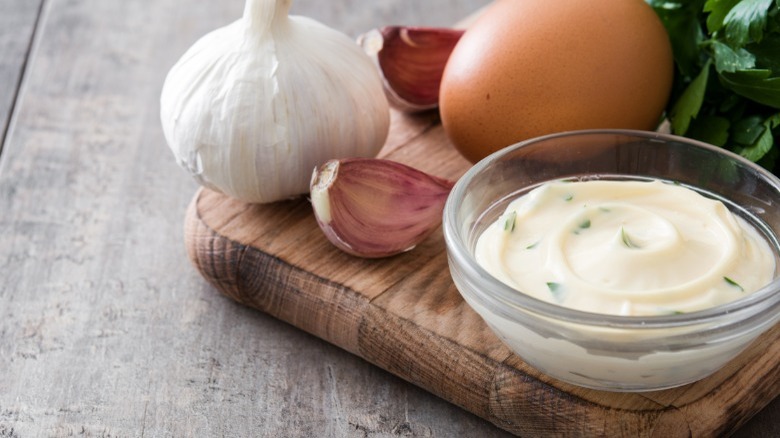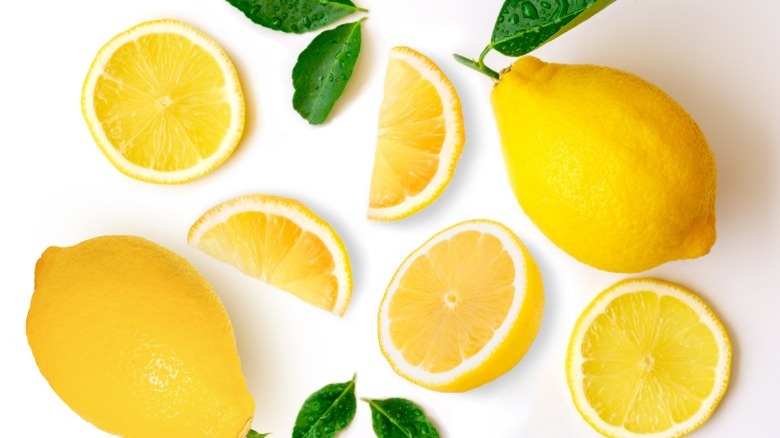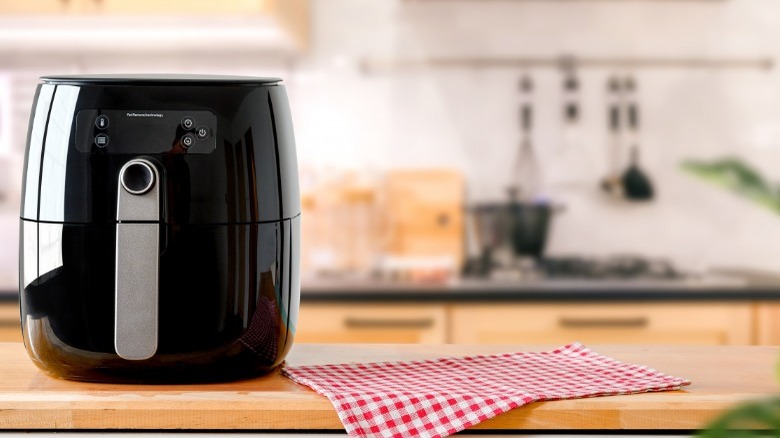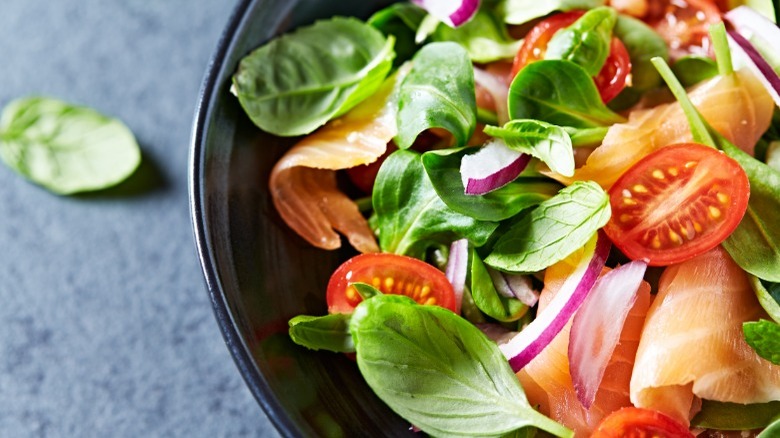15 Tips You Need To Make The Tastiest Salmon Cakes
If you grew up enjoying meals made with canned pantry staples, then there is no doubt salmon cakes made their way to the menu every now and then. The little patties, which typically consist of canned fish, bread crumbs, and an egg, come together quickly and only cost a few dollars to make.
Plus, they are super healthy! Salmon is loaded with heart-healthy omega-3 fatty acids and is rich in vitamin B12, which helps regulate your body's nervous system. This cost-friendly source of protein can be enjoyed straight out of the can and will save you money without missing out on all those essential nutrients. One of the best ways to take in all that good stuff is by whipping up a few salmon cakes.
You'll love scavenging your fridge and pantry for whatever ingredients you can find to make them, as they take well to new flavors. From cooking your aromatic ingredients beforehand to experimenting with fresh ingredients until you reach the perfect taste, we have a few tricks up our sleeves.
Repurpose leftover ingredients
The thing about salmon cakes is that you have a lot of freedom with the ingredients and the outcome of this dish. Keep it simple, or make it fancy — the choice is yours. You can bring lovely elements like minced shallots and fresh dill into the mix before shaping pretty little croquettes for guests. Or you can rummage through your fridge for leftover ingredients and make a straightforward dinner with little effort.
Leftover salmon and any other mild fish will combine well and taste lovely in your savory patties. Consider using your surplus of chopped onion, leeks, or minced garlic. Leafy greens like cooked chopped kale or spinach will bring a healthy vibe to your dish, and chopped cooked carrots will help provide a subtly sweet component.
Unless you have a planned dinner with friends, go for effortless, and repurpose those leftover ingredients. Just like you can make a cake salé with the help of leftovers, you'll have no trouble turning kitchen scraps into a batch of savory salmon cakes. Just be sure to use ingredients that balance well texture-wise. You don't want your mixture to be too wet or too dry.
Make sure your mixture isn't too wet or too dry
For your patties to stay together and cook without falling apart, you must get the moisture just right. That means if you plan on using leftover ingredients, you should first consider how much water they give off.
For example, cooked cauliflower and zucchini are considered high moisture-content vegetables and could make your salmon cake mixture too wet. If you run into this problem, consider adding some breadcrumbs or crushed Ritz crackers. To avoid this issue, use a clean dish towel or cheesecloth to remove any extra water.
More often than not, you'll run into the issue of overly dry salmon cakes, which can no doubt cause them to fall apart while cooking them. Most recipes call for an egg, which provides moisture, and helps bind the ingredients together. Larger batches might need an additional egg to help keep everything moist and intact.
Consider whisking a second egg and adding small amounts at a time to help revive your mixture. Otherwise, small amounts of mayonnaise or crème fraiche will help provide a touch of moisture — but do not overdo it.
Try using other binders
If you search for any salmon cake recipe on the internet, you'll find most fall under two main categories. They are either made with breadcrumbs or mashed potatoes. Breadcrumbs and mashed potatoes offer lots of carb-filled love as a primary filler, but their most important role is their binding abilities.
Breadcrumbs combined with an egg, some mayonnaise, and a few other flavorful additions are commonly used to help keep the flakey fish within the patty so it won't fall apart. Mashed potatoes work beautifully in the same way. Flaked salmon, mashed potatoes, and egg come together when it's time to form those patties, but your potatoes must be just right.
Leftover cold mashed potatoes work well because they are firm and help keep everything together. If you decide to make mashed potatoes for salmon cakes, drain them well, so they are not too wet or soupy. You can even reach for instant mashed potatoes in a pinch, which binds well in any potato cake.
If you don't have any breadcrumbs, or mashed potatoes, consider crushing up ritz crackers for your binding filler. They soak moisture well and provide a salted buttery flare that tastes fantastic in salmon cakes.
Experiment with different breadcrumbs
As we said, salmon cake recipes usually call for breadcrumbs, and there is a good reason for that. They help provide a tasty filler, and as long as you don't add too much, they'll help give the body without burying the fish too much. They also help coat the outside of your salmon cakes and offer a much-appreciated crispy exterior if you plan to fry them in some oil.
Many different types of breadcrumbs are available, and what you use will make all the difference in texture and flavor. There are very few scenarios in which we recommend regular breadcrumbs over panko. Panko breadcrumbs are different than regular ones because of the type of bread and the process used to make them. Panko offers a superior crackling crunch over other kinds of breadcrumbs.
Whatever your recipe calls for, you won't have to do any fancy mathematics to substitute one for the other, as they can be subbed in equal amounts. If your pantry doesn't have either, you can always turn your leftover baguettes and stale loaves into crumbs.
Cook your onion and garlic before adding them to the mix
You'll find aromatic ingredients like onion and garlic in various savory recipes, and their role is significant. Vegetables and herbs that add generous flavor and aroma to a dish help provide a well-rounded flavor base.
When making salmon cakes, most recipes call for a small clove of garlic, a diced shallot, or a small onion. Some recipes will call for less pungent aromatics like leeks or green onion instead. When using these ingredients, remember how much they differ in flavor and texture when consumed raw versus cooked.
Raw onion and garlic, in particular, boast a crunchy texture and naturally astringent flavor that can be too sharp in certain foods. Because your salmon cakes are served warm with mainly cooked ingredients, consider cooking your onions and garlic in a dab of butter before adding them.
The softened onion and garlic will boast a subtly sweet flavor which always complements the other savory ingredients in the salmon cakes.
Fresh salmon offers superior flavor and a lighter texture
As we said, salmon cakes can be as sophisticated or as simple as you would like, depending on which ingredients you plan to use. For a swankier version of these little fish cakes, we recommend working with high-quality ingredients, including fresh salmon.
Using fresh salmon means you have a little more freedom over texture. While canned salmon is by far one of the healthiest proteins you can score from a can, the texture is always a bit firm compared to a perfectly cooked salmon filet. Cooking it yourself will also allow you to add whatever seasonings and fat you'd like to the skillet, which will transfer to your salmon cakes nicely.
If you are lucky enough to live in New England or anywhere along the coast, you might even have the opportunity to select fish "off the boat." That means its freshness is superior to anything you will purchase in a supermarket.
Canned salmon is fantastic too
Off-the-boat fish might provide the freshest flavor, but canned salmon is fantastic too. Not only will you still reach all those health benefits from cranking open a can, but you'll save a lot of money by going that route.
For only a few dollars, you can enjoy a serving in any way you choose, as there are many ways to use canned fish and seafood to improve your cooking. Canned salmon is one of the healthiest proteins available off the shelves of any supermarket; even the American Heart Association recommends enjoying two servings per week to reap those benefits.
One of the best ways to get at least one or two recommended servings is by making a batch of salmon cakes, and most recipes call for the canned stuff anyway. Consider keeping the skin and bones there for an additional boost of calcium and omega-3 fatty acids. They are perfectly safe and can be concealed by mixing them. The bones within a can are soft and nearly disintegrate when mashed down, making them safe to ingest.
Chill your salmon cakes before cooking them
If you are working with warm ingredients like freshly made mashed potatoes or cooked fish, you'll need to give your patty mixture a quick cooling session before forming them. Working with any fish cake is a delicate process, and unfortunately, they don't always like to keep their shape. Sometimes too much flakey fish gets in the way, and the mixture is far too dry to stay together.
In other scenarios, the mixture is too warm, especially when making salmon cakes with mashed potatoes. Ever feel the difference between a hot batch of mashed potatoes and refrigerated leftover mashed potatoes? That smooth, creamy consistency of warm mashers transforms into a cold hard clump of potatoes after spending time in the fridge.
Technically this is a good thing when forming patties, so be sure to form each salmon cake, chill in the fridge for at least 30 minutes, and cook them afterward. They should have no problem staying together while frying them up.
Use an ice cream scoop to form them
Speaking of forming your patties, you will appreciate Ina Garten's trick for making perfectly even fish cakes every time with the help of an ice cream scoop. The beloved Food Network chef sure knows how to find a unique use for tools outside of their everyday use, and this is a prime example.
Using a two-and-a-quarter-inch ice cream scooper, you can dig into a chilled bowl of fish cake mixture to create several three-inch salmon cakes. For smaller appetizer-sized croquettes, consider using a small scooper instead. Not only will you save your fingers from a messy job, but you'll be able to create uniform cakes that all cook evenly.
The versatile tool will help form all sorts of foods besides fish cakes. Next time you need to shape meatballs, reach for your scoop and enjoy how quickly it brings a whole batch together. It's also just the tool you need for scooping pancakes or muffin batter before making sweet treats.
Fresh herbs will add a depth of flavor
While dry herbs are best used in hot stews, soups, and anything that simmers all day, delicate fresh herbs can show off their stuff in most other dishes. Sandwiches, salad dressings, and fresh dips all shine bright with the addition of freshly picked herbs because you aren't cooking them. The earthy notes have a chance of standing out in their freshest form while adding nuanced flavor you won't find in any other type of herb.
Salmon cakes have quick cooking times, no matter how you plan to warm them up. Some fry them in a pan, while others bake their batch. Regardless, you'll get away with adding herbs like baby dill, fresh parsley, chives, mint, and green onion without breaking them down too much.
Dill and salmon especially pair well and are commonly used together in recipes, so the dilly addition will be much welcomed within the mixture. If you'd rather keep your salmon cakes free from green, consider adding fresh herbs to a cool dipping sauce instead.
A dash of Dijon goes a long way
Salmon's mild taste means you can work with a plethora of flavor profiles and combinations to help jazz up your meal. The fish tastes fantastic when served with sweet ingredients like honey or maple syrup, but tangy, bright flavors from a lemon and other citrus fruits also amp things up.
Savory ingredients like soy sauce and capers go well with salmon, but you can also let the fish swim in a hot buttery cream sauce, and the final product will turn heads. Even Dijon mustard has a way of bringing out the best in cooked salmon. While the mustard alone tastes far too spicy, it pairs beautifully with salmon and other types o fish.
One of the best ways to show off this combination is by making a batch of salmon cakes and adding a smidge of your favorite brand to the mixture. You'll appreciate the well-rounded flavor thanks to the sharp tanginess in salmon cakes a la Dijon.
Don't skimp on dipping sauce
The overall flavor of your salmon cakes and what you put in them no doubt matter, but that doesn't mean you can forget the precious dipping sauce. There are many ways to serve your salmon cakes, but no matter how you plan to, always offer something tasty to dip them in. There are endless types of dips that go well with salmon patties, and you can even try whipping up a signature recipe for fun. But if you need some inspiration, we can help with that too.
Consider making a Louisiana-inspired remoulade sauce that combines mayo, horseradish, ketchup, Dijon, lemon, capers, hot sauce, and a few more for good measure. While the dipping sauce has several ingredients, chances are you have most of them at home. The flavor goes wonderfully with salmon cakes, so be sure to give it a try.
For something a little easier, try a homemade garlic aioli sauce made with lemon, garlic, a couple of eggs, and olive oil. Otherwise, tartar sauce, lemon garlic butter sauce, and creamy dill sauce taste lovely too!
Bring on the brightness with lemon
We all know fish and lemon go hand in hand because acid and salt balance each other well. No wonder you'll find a wedge served with most fish and seafood plates at any restaurant. When making salmon cakes, be sure to use those tangy citrus fruits to your advantage.
There are plenty of ways to bring brightness to salmon cakes using lemon. Either zest right into the mixture or squeeze a few tablespoons instead. Otherwise, consider serving them with a lemon wedge as they do in restaurants.
A fresh squeeze over the top right before serving will help bring a zesty flare that will help awaken your tastebuds and prepare them for a delicious meal. The acidity in the lemon will also help cut down on the heaviness you might taste if you decide to fry them in oil, so be sure to have a few next time you make a batch.
Try different cooking methods
Salmon cakes are often prepped, shaped, then fried in a bit of oil to ensure even crispness on each side and along the edges. But that isn't the only way you can cook them up. If you want healthier ways to bring on the crunch, consider making 15-minute air fryer salmon cakes instead. A few modest ingredients will come together in a flash and provide an air-fried version of salmon cakes with a massive slash in fat and calories.
If you don't have an air fryer, you should buy one. But, seriously, in the meantime, consider baking your salmon cakes in the oven. This rye-and-salmon cakes recipe is a bit more complex but browns nicely in the oven and tastes delicious with the homemade dill sauce.
No matter which way you choose to cook your salmon cakes, do your best to aim for a crispy exterior. The soft, warm center and crunchy exterior provide a pleasant experience we call a good mouthfeel.
Serve them right
While there are plenty of ways to cook salmon, when it comes to serving salmon cakes, the choice is ultimately yours and depends on what foods you already enjoy eating. For something bright and creamy, consider serving a few patties with a heaping spoonful (or two) of avocado salsa. The fresh avocado will help perfectly compliments the savory flavor of salmon cakes and provide a great contrast in temperature your taste buds will love.
Otherwise, consider throwing a few salmon patties over a bed of fresh field greens. From there, select a few choice ingredients like cherry tomatoes, and blitz a lemon vinaigrette for your salad. Cole slaw offers a lovely vinegary tang, and that crunch will accompany your fish cakes well. For something a bit heartier than fresh salads, slaw, or salsas, you can even serve them with seasoned French fries or buttery corn on the cob.
